My Trip to Brazil
A journey diary of my trip to south america
blogsao paulobrazilcampinasenergy informaticsconferencetravel
4253 Words
2023-12-09
In December 2023, I visted Brazil for the first time and want to share my experiences, as well as the content of the conference I attended. This also should give a small insight into typical experience attending research conferences.
Maybe a TLDR for future Brazil Travels:
- I did not need cash, credit and debit card is needed
- The metro is generally very safe
- Uber is a good option to get around else
- The tourist information is worth it
- Most museums are closed on monday
- typical tourist spots (Beco do Batman, Avenida Paulista on sunday and the Ibirapuera Park) are worth it
- The historic center is worth it with a free walking tour
- There aren’t many people in the service sector who speak english - touristic regions might be better, but I try to avoid these
São Paulo
The plane landed at about 06:20 and after I got out of it, I felt the warm weather and did take off my jacket, which I kept on during the flight, which is usually quite cold (even though a very small blanket is given by the airline for sleeping). I had slept more than 6 hours while being on the 12 hours flight, which was quite acceptable for me. I had a temperature delta of nearly 30°C, as it was already quite cold in Germany.
After standing half an hour in the waiting queue to enter the country, I came to receive my luggage. Interestingly, in the plane I heard that you have to check out, take your luggage yourself and check in again if your second flight is intracountry. From the airport, I traveled to my hotel by using an Uber, as I did not know a lot about how to travel there and just wanted to get to my hotel. In the hindsight, I could have used one of the Buses which are going from GRU airport into the city.
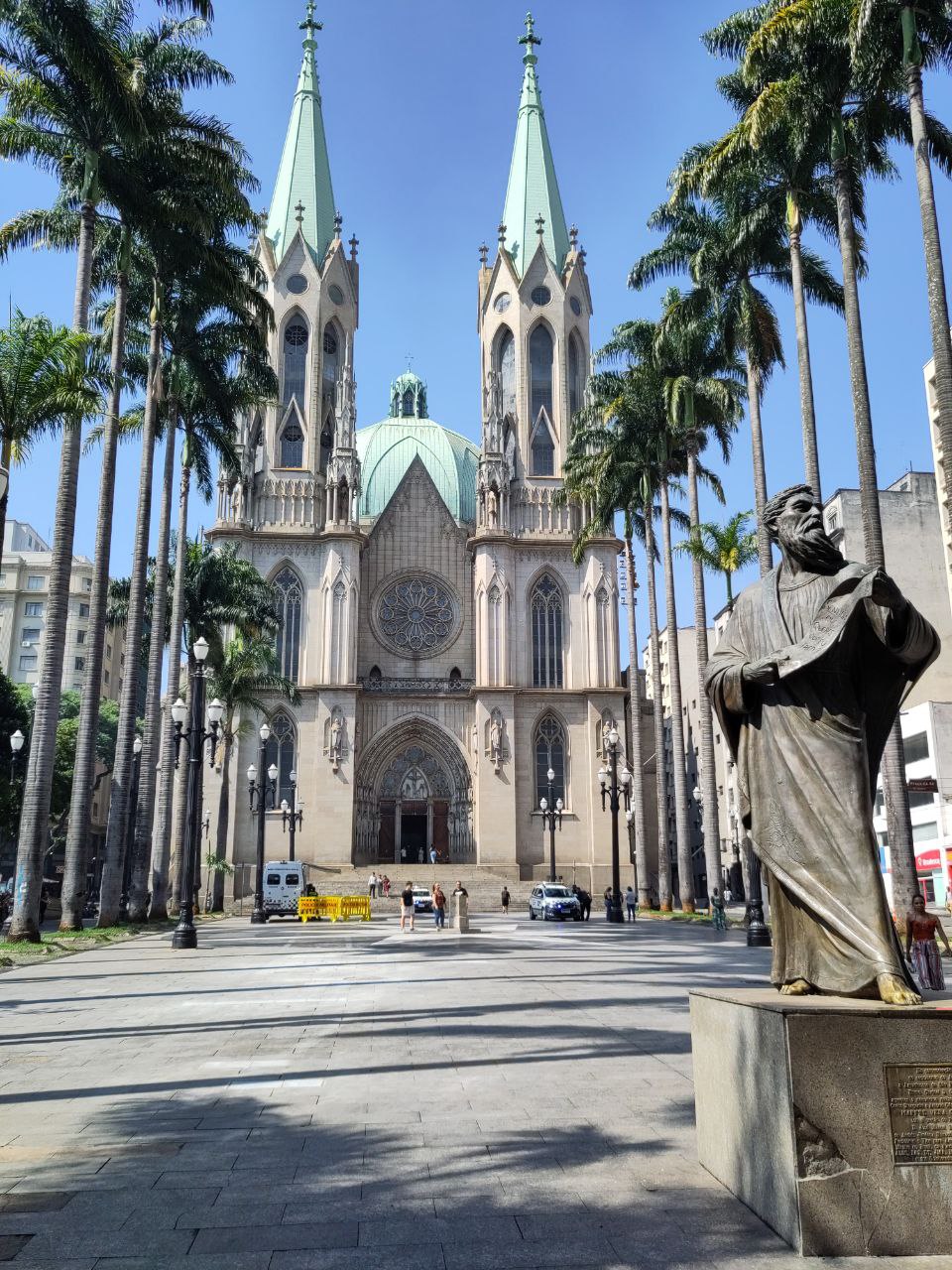
Sao Paulo Cathedral with Saint Paul in front in Sao Paulo
The driver was very nice and could speak a little bit of english, gave me his personal phone number - so that I can call him, which is cheaper than using Uber as a middleman.
As I would have been charged extra if I wanted an early checkin, I just dropped my luggage and went into the city. I wandered around the city a bit, just to get a feeling of the people and shops and everything.
I went to an Art Gallery which took place near the Historical Museum of Japanese Immigration in Brazil. The art exhibition was for free.
As the visit of the Meseum did only cost me 8 BRL, I also looked into that. It was quite hot, so I did spend a little more time there and also learned a lot about the immigration history.
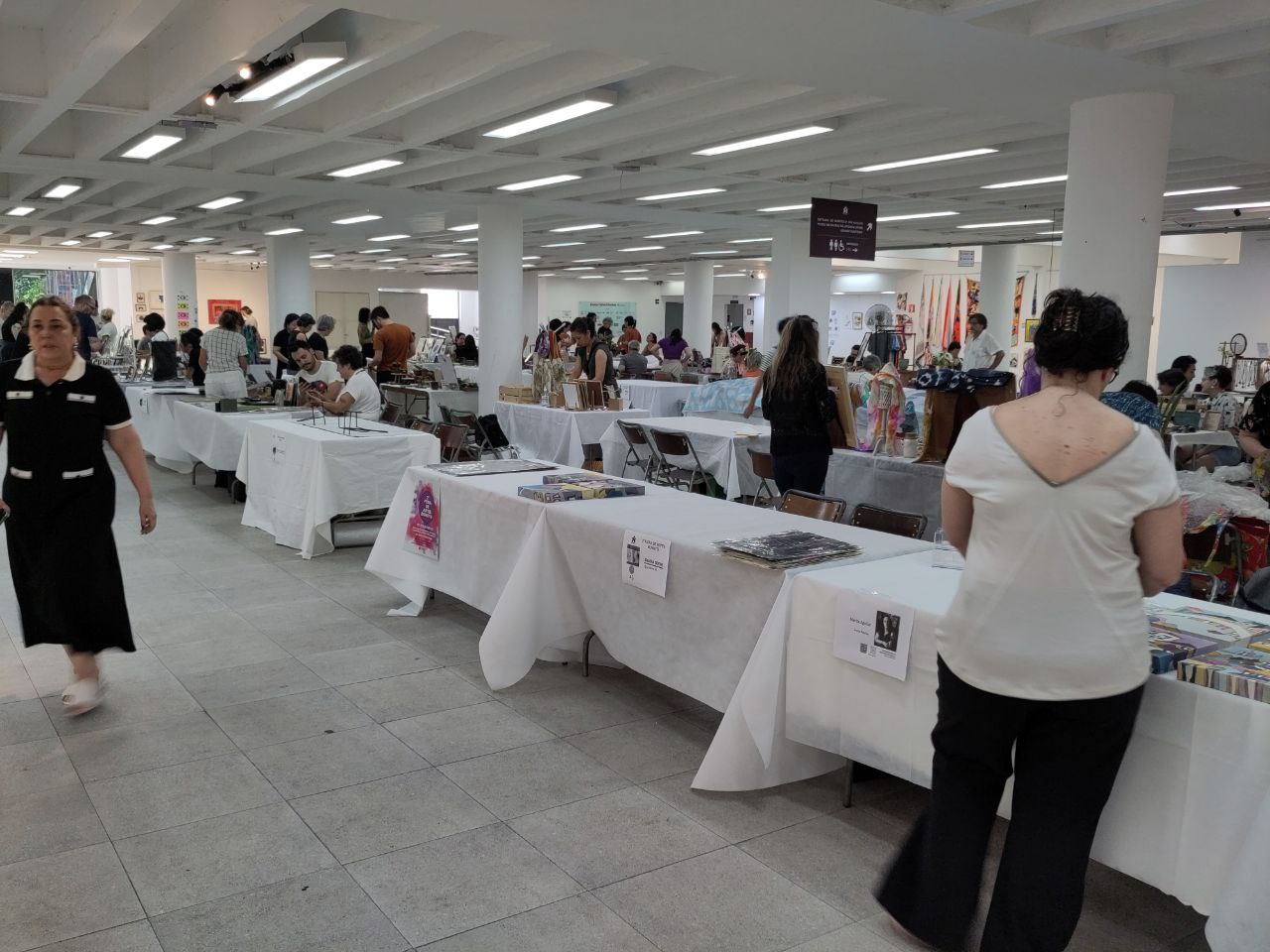
Free Art Exhibition of local and international artists
Historical Museum of Japanese Immigration in Brazil
Most of what I learned about the Japanese-Brazilian history is also summarized here: https://revista.drclas.harvard.edu/the-japanese-brazilian-community/
But what I found especially interesting was the conflict between the Kachigumi and Makegumi after the second World War. The Kachegumi did not believe in the Defeat of Japan which ended WW2 due to a ban on local newspaper japanese language in Brazil. While the Makegumi did accept this, which lead to conflicts with deaths in the japanese community in Brazil. https://www.ndl.go.jp/brasil/e/s6/s6_1.html
This reminds me that it is very problematic if people have strong believes in cults and do not read the facts correctly. In general, this is also a problem, which we are facing in some of our current global conflicts, where sovereignty of interpretation is not given.
The museum in general was very interesting and often gave different views on the same time period, which are also often both true at the same time. So not everything which looks differently has to contradict another version necessarily.
Back in the city
Before getting back to my hotel, I got some lunch at a brazilian fast food restaurant Habibs’s at noon. In the TV, a female skateboard championship was shown, which was also very interesting. It took me some more time to order food there due to language problems, but it was good.
As it is December, it is quite warm in Brazil as they have summer there. But december is still christmas time, so they also have decorations around:
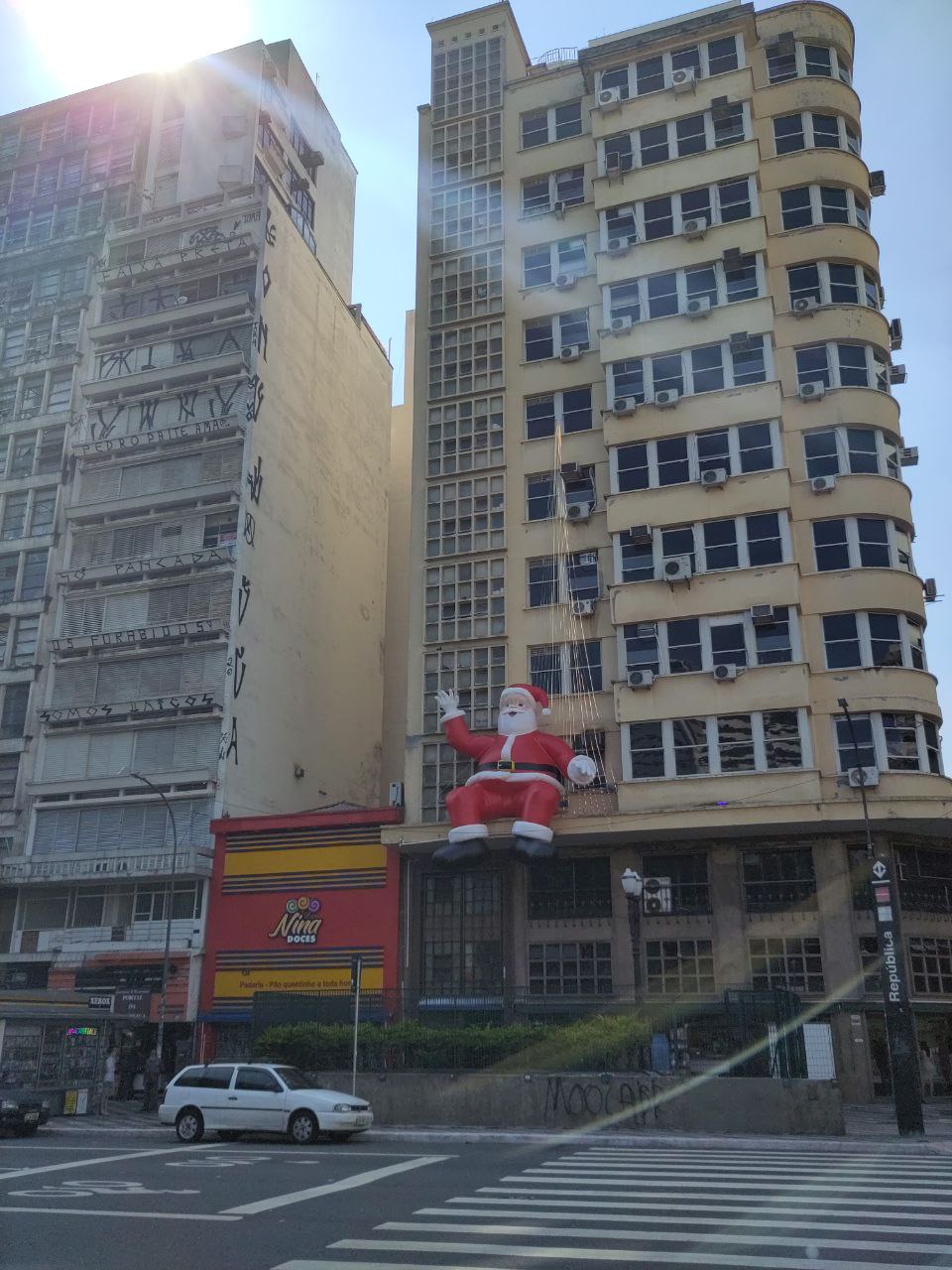
Christmas decorations in Sao Paulo
After staying some time at the hotel, I met up with some guy from Germany to visit some more touristic parts of the city. In general, it is much safer to not be alone while walking through the city.
As it was sunday, I visited the Avenida Paulista, which is one of the main roads.
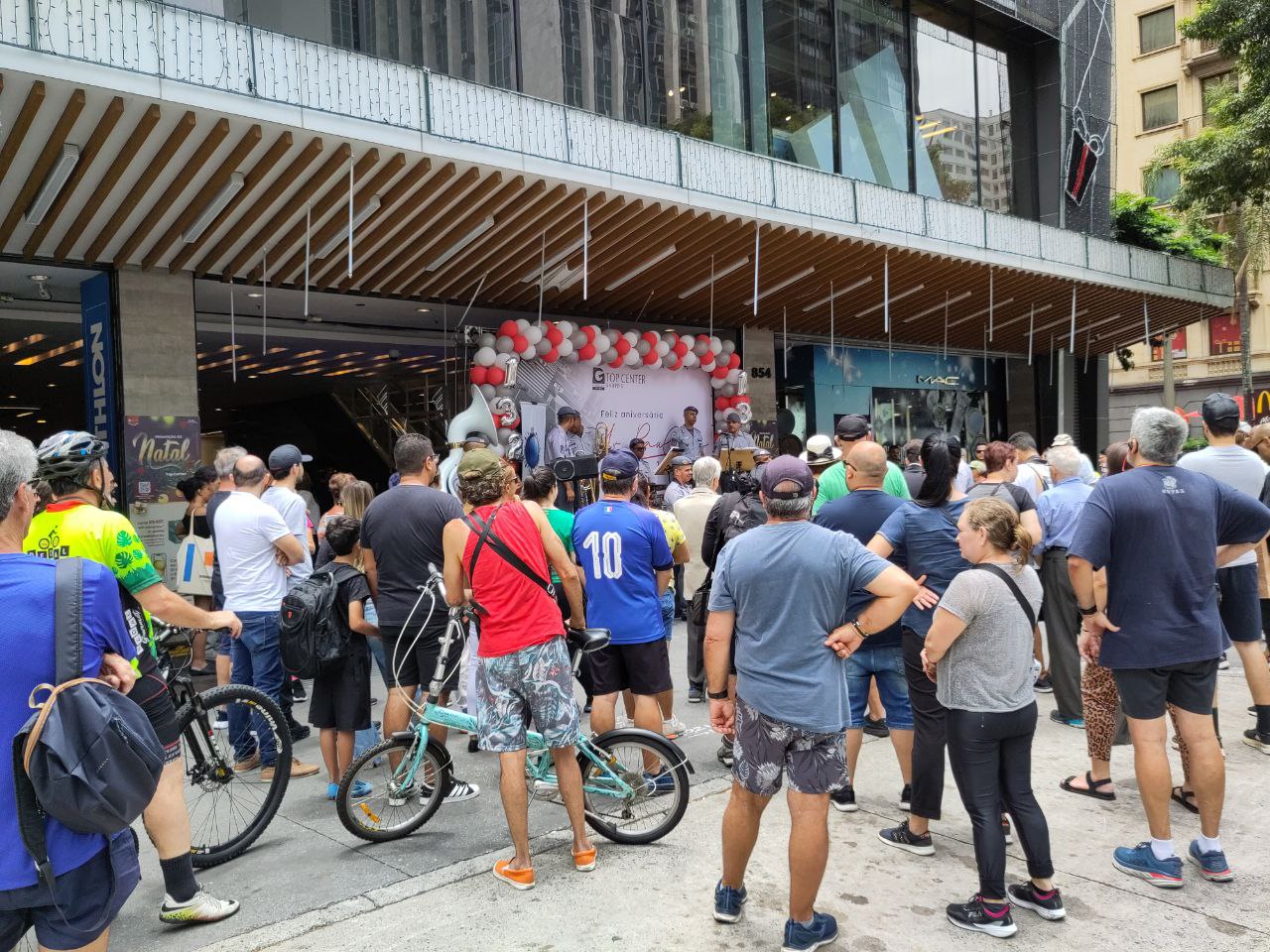
Police Band playing on the avenida paulista
It is closed every sunday for cars, and all people can go there - typically a lot of music and marches are played. It felt a lot like Carnival.
I am quite sure that the brazil live music occasions are my favourite.
After meeting up with the other German guy, we went to see the beautiful Beco do Batman, which is a very nice street with graffiti and streetfood. In general, the area around Villa Madalena and Pinheiros are quite nice to visit.
After having a nice walk around in the Ibirapuera Park, we went to get some food. On the way to get food, we also came across the Obelisk of São Paulo, which is a quite big monument.
We visited a few restaurants but did not like to have something with too much fat, so we skipped about three ones and settled for pizza. After finishing, I went home alone at 8 o clock. You can read a story about my trip home here.
Second day in São Paulo
I went alone to the Avenida Paulista to see some parts I did not see the day before. I visited the Shopping Cidade São Paulo, which is , which also contained a Lindt store and was very european/american, I did not feel like buying something from one of the large brands there, but it was a cool place in general.
After that, I went to the Parque Prefeito Mário Covas which also holds the building of the tourist information. Here, a nice person gave me some tips on other things to do and which museums are interesting.
Unfortunately, the city does not have that many interesting spots, so I just walked around to eventually see some of the museums, as they also lined up a good route for me.
While walking around, I also have seen a lot of gates and double gates (like an airlock for cars) in the more premium communities. It is very interesting that so different kind of people are often just living one street away in São Paulo.
Another thing which is very interesting is the amount of electricity and telecommunication cables they have stretched over poles and the night lanterns. It looks like something that no eletrician would like to fix, but if it works, it works.. Somehow, this is also quite common in southern european countries.
In the metro station, they had markings on the ground which tell you to stay at the left and right side of the doors, so that people can stream outside of the tram. This is quite efficient for medium stations, while larger stations have one dedicated side of the trolley for leaving the metro and another one for entering it.

Metro station with railing and markings - entry and exit is on the same side
This felt very efficient. Generally, the metro is a very safe, cheap and convenient way to go around the cities in Brazil.
Pinacoteca
I liked to walk around in the old city center too, where I visited two of the three buildings of the Pinacoteca.
The way towards it included walking past a lot of homeless people near the station of Luz. So the area is really not nice, but the contents were.
Afterwards I went back to my hotel by foot, which was also one of the less secure experiences, but I just kept moving and did not have problems. When I arrived in an area where the shoes are laying on the outside of the shop, I felt safe enough again.
I planned to visit the local hackspace of São Paulo and contacted them through the website, but there wasn’t someone who felt familiar enough with the english language to give me a short tour and come to the hackspace, which is fine.
So I found an interesting brazilian imbiss restaurant which had a turnstile at the entry, where you had to take a card, which is used to as an electronic proof of the things you ordered. Therefore, you only pay once when leaving (also with a turnstile) and can not go out without paying.
After eating a Burger with brazilian extras there, I went back to the hotel. The next day, I traveled to Campinas by Bus.
The Terminal Tiente is also very safe and riding one of the travel buses to get from one city to another works also very well. But you do need to bring your passport with these, as it is needed to show it before entering the bus.
Energy Informatics Academy 2023
After breakfast, I saw that a few chinese people seemed to go to the conference too and asked them if I could join their Uber. Which was quite a nice way to get a first interaction and small discussion about their topics. Somehow, they went by plane from Hong Kong and had a transit in Paris, while it would have been much shorter to travel over the other side of the world. But there were no flights available with a transit in New Zealand or they were much more expensive.
In general the conference seems to handle a lot more topics which are regarding AI and forecasting than simulation and modeling of energy systems. The two days before the conference, academy workshops about the forecasting of timeseries and other AI topics was planned. Unfortunately, the workshop was cancelled due to illness.
The Conference takes place in the center of FEEC at Unicamp Campinas near São Paulo. After introducing the important organizing people of the conference, and presenting the agenda, the keynote started.
Keynote
The first keynote handled the specialities of the brazil energy system which is highly based on the availability of hydro power. Which also differs throughout the year.
Other than that, brazil also has 2 nuclear plants, few coal and a lot of biomass powerplants. Most engines can run on ethanol (from sugar canes) as well as on gasoline, which I also found interesting.
Due to hydro power plants, which are making up more than half of the power capacity in Brazil and other renewable sources, the amount of renewables is more than 70%. In the future, the amount of Solar and Wind powerplants will raise to reduce the conventional power usage of the industry and transport sector.
Besides the possibilities of this, I somehow ask myself how this can work out in an energy system which also has a lot of weird hanging lines across the cities. I did not see electric cars somewhere yet and I do not really see how this transition can happen here, especially due to the less wealthy people.
However, the targets they aim for are very good, honorable and needed. And I do not really see, how the path to going full renewable will be solved in Europe too.
Further on, the different research projects were represented, which take place here at the campus.
In Campinas, they have a few microgrids for university buildings, which is capable to work independent of a blackout in an island mode. They operate it with about 140kW of power generation.
I began to think about if this would be a possible direction in Germany, so that every city has enough storage capacities to get itself through the winter without external power at all. Just like the law of large numbers, a distribution gets much smoother, the larger it gets, as small deviations cancel each other out, so I doubt that this is a generally practical way.
The way that buildings with a very crucial uptime requirement have emergency power supplies at hand, and everything else is handled centrally, seems much more practical. Of course, it would be very interesting to create a simulation of this, to also create some quantified numbers about this topic.
Paper sessions
The paper presentations were quite interesting. They tackled simulation of Green houses, The quality of the presentation varies a lot through out the presentations. Of course, some included a lot of IT buzzword bingo (AI, VR, AR and blockchain on one slide). Most of the topics are covering the use of Machine Learning in some way, to solve forecasting or classification problems.
A lot of publications were tackling the use of Electric Vehicles and their influcence on the grid.
Somehow I have been the only one with a topic about wholesale energy markets. Other papers included the use of a price signal from the market and finding the best bidding strategy (for EVs) while another paper contained a multi-agent simulation. But it seemed like this topic was not the main point there. I hope that there are more people in this field on the European Energy Market conference next year.
I was very happy with my presentation, and some conference participants came to me afterwards and said that they liked it. The discussion after my presentation was very fruitful.
Conference Evenings
At the evening I have been to the pool and enjoyed the warm weather of brazil, ate a mango and went to the restaurant which has been selected.
We have been to a restaurant, which did have local food and also very nice live music, so-called “Choro”.
Unfortunately, the restaurant was not very well organized, so it took more than two hours and multiple requests to finally get the food we ordered. As we were there with all the conference participants, it wasn’t a big problem, as we had things to talk about and it did not get boring, still it was a little annoying.
Conference Dinner
The second evening, the conference Dinner took place, which happened at a very big restaurant and was called a banquet. We were not disappointed. So there was a buffet with various local food and meals, while many servers went around with meat on a long iron knife to serve parts of it with a knife to everyones plate. There were also a lot of vegetarian food options, so even if the brazilian food culture is based a lot around meat, one could get along at this place quite well.
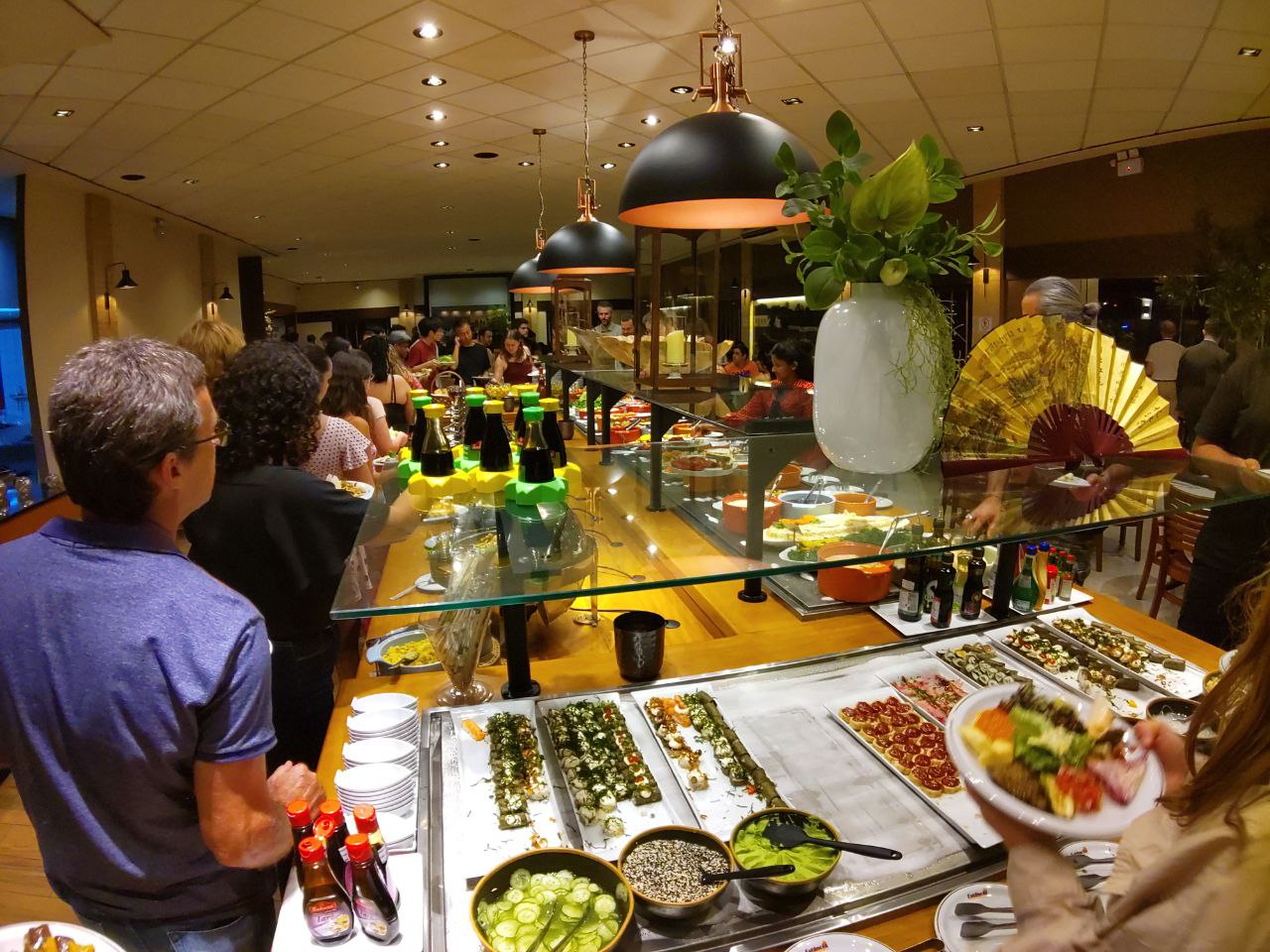
Conference Dinner Banquet with Buffet
The highlight for me was the hot pineapple with sugar. Which was also served on one of the long iron knifes and cut off with a second knife.
So this was a very interesting experience.
Last Day - and São Paulo again
On the last day after the conference, we wanted to go bouldering in the boulder hall of Unicamp, but it was closed due to a holiday in São Paulo.
We then went to the pool and afterwards into the city of campinas to eat something. We found a vegan bar which had forró live music. We drank some agua de coco and ate brazilian sandwiches there and had a good time.
Afterwards, we went back to the hotel to take the Uber to Sao Paulo the next day.
There, we joined a free walking tour in the historic center of Sao Paulo, which was quite interesting, as this is also an area which is not too safe when going around alone.
We slept in a Hostel which was quite good and had a music inspired rooms. Unfortunately, the prices were a bit higher, due to a Paul Mc Cartney Concert in Sao Paulo at this weekend.
The next day, we went to see the avenida paulista again (as it was sunday again), before we took our travel bus towards Rio de Janeiro.
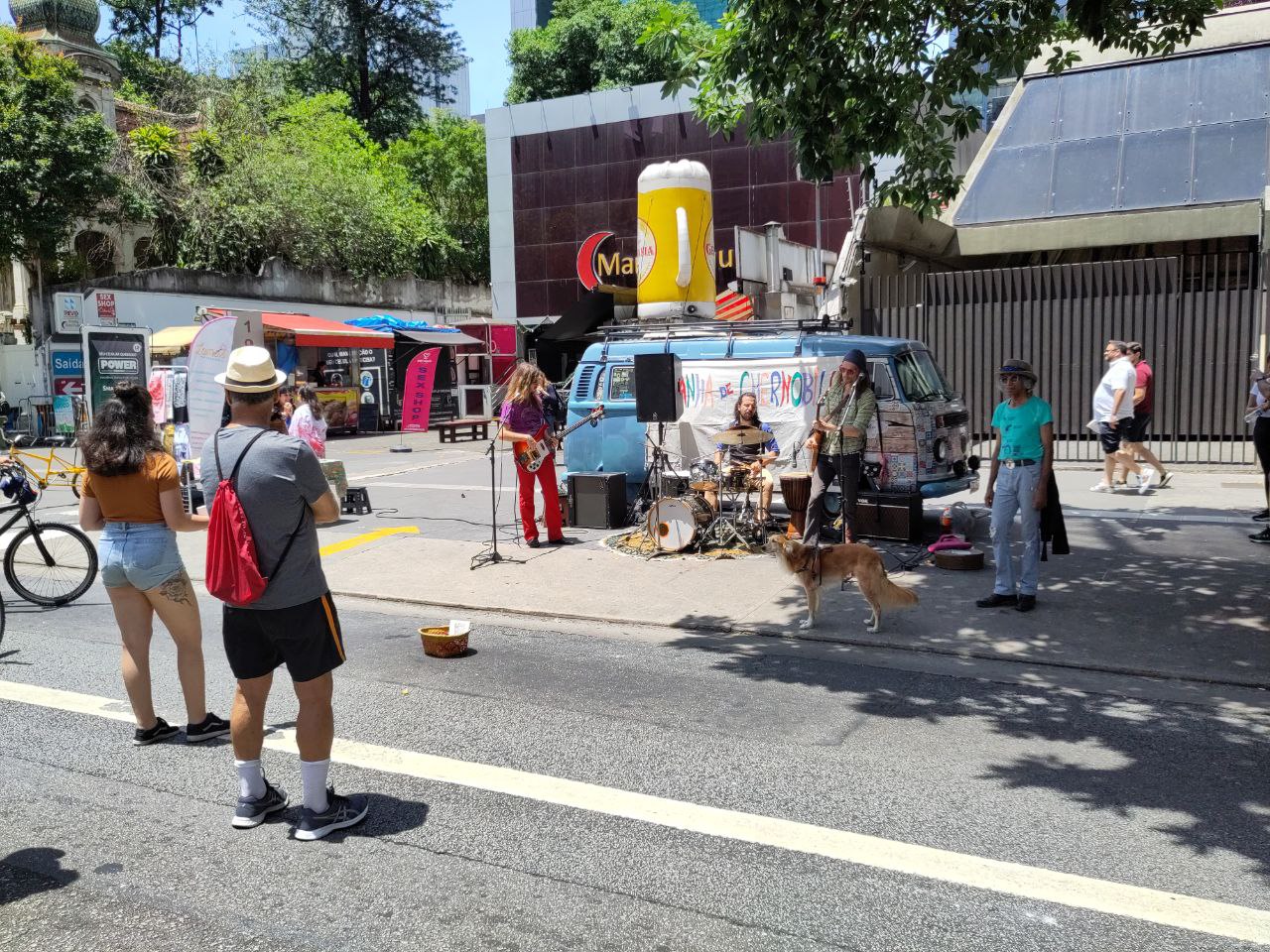
Rock Band playing on the avenida paulista
Rio de Janeiro
We came to Rio at night by a travel bus, from sao paulo. The bus was of very good quality. We had to rebook as flixbus was cancelled here, but it was no problem, as plenty bus options are available at budbus for 100 BRL.
We arrived an hour late due to traffic at 21:30 in Rio. Taking an Uber to the hotel worked great, and the hotel was also very nice. After getting into the rooms, we also wanted to explore the city of Rio a bit and get something to eat. As the hotel is directly in Lapa, one of the areas with a crowded night life (except for on monday), we did not need to search for a long time to finda a place to eat there.
Still, as everything was so crowded and full of people who did not look necessarily trustful, we did not yet feel very safe here. We still sat down outside of a restaurant and observed the night life while eating pizza and having a suco. After being a little afraid, that we won’t feel that safe in this city, we went back to sleep.
Free walking tour
The next day, we attended a free walking tour in Lapa. It was a nice way to get to know the city, some infos and the main sightseeing buildings.
A must-see is the interior of the cathedral and the Escadaria Selarón
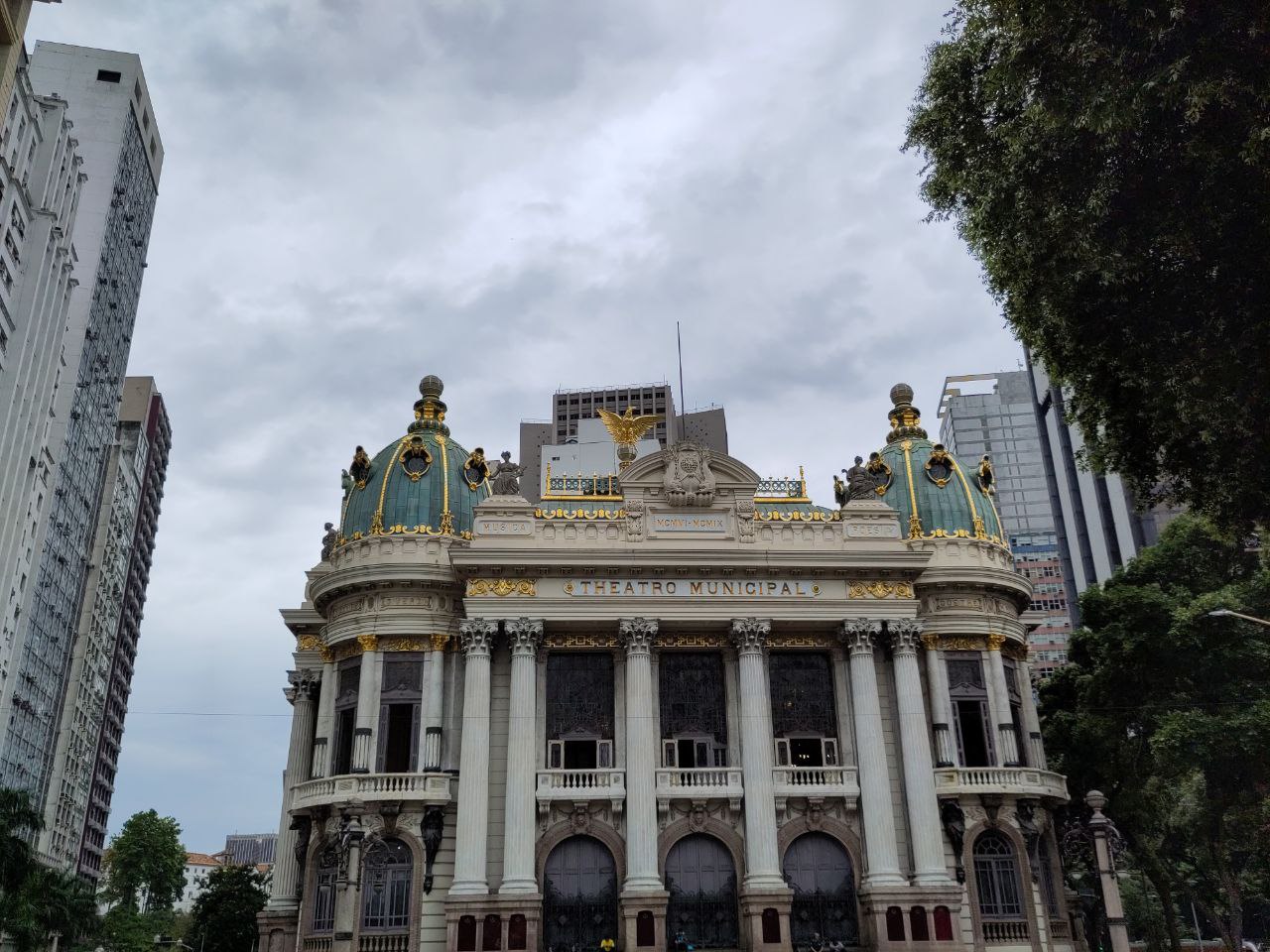
The Municipal Theatre in Rio
The hotel also has a very nice view towards the Cristo Redentor. But the city does not look that good in that direction. Generally, most houses are not in a very good condition, as renovation is quite expensive.
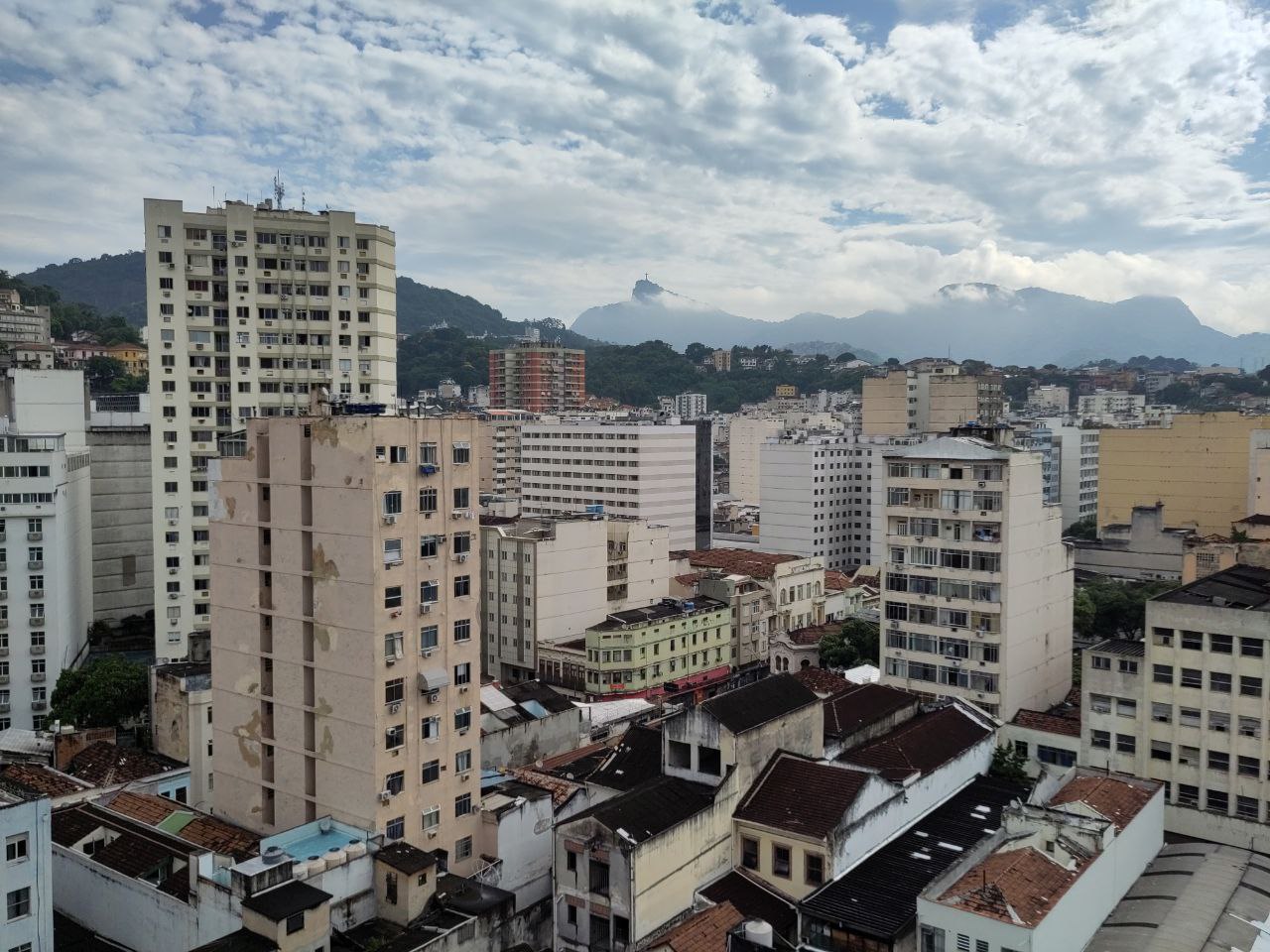
View from the hotel towards the redeemer
In the evening of that day, we got some fresh fruits from a store and relaxed at the rooftop. The mangos and maracujas are very good here.

Fruits in a local store in Rio
Bus ride
We took a ride with a bus one day, which was a very intersting experience, as the bus driver did not have any sense of european safety measures at all. Traffic lights are seen as a rough recommendation at best. So they just slowly approach the crossing and drive over it. If it looks empty, they just honk the horn a few times and drive without slowing down over the crossing. Also, when approaching a stop the bus already opens the doors - so that they are open when the bus stops. It then drives away with open doors and closes them while driving away. This of course results in a much faster bus driving experience than I am used from Germany.
We also saw a bus doing an emergency break (by the driver), because the bus did forget to stop at a station. After leaving breaking strips on the road, it just went back in reverse gear for more than 100 meters.
Redeemer
We visited the Redeemer (or Cristo Redentor, as it is called in Brazil) on its mountain corcovado by buying the tickets from the official store with the cogwheel railway: https://www.tremdocorcovado.rio/ It is a little cheaper when booking a day before, the “skip-the-line” ticket which is suggested on some websites was not needed for us, but we went there at 8:20 in the morning. One does need an ID to proof that you are yourself though. One could feel that it was getting more crowded the longer we have been there, so it really makes sense to go in the morning if possible.

View on the city of Rio de Janeiro as seen from the Redeemer statue
The view is really good as you can see how enormously large the city is. Rio de Janeiro also looks very green, as it is surrounded by a lot of green forests.
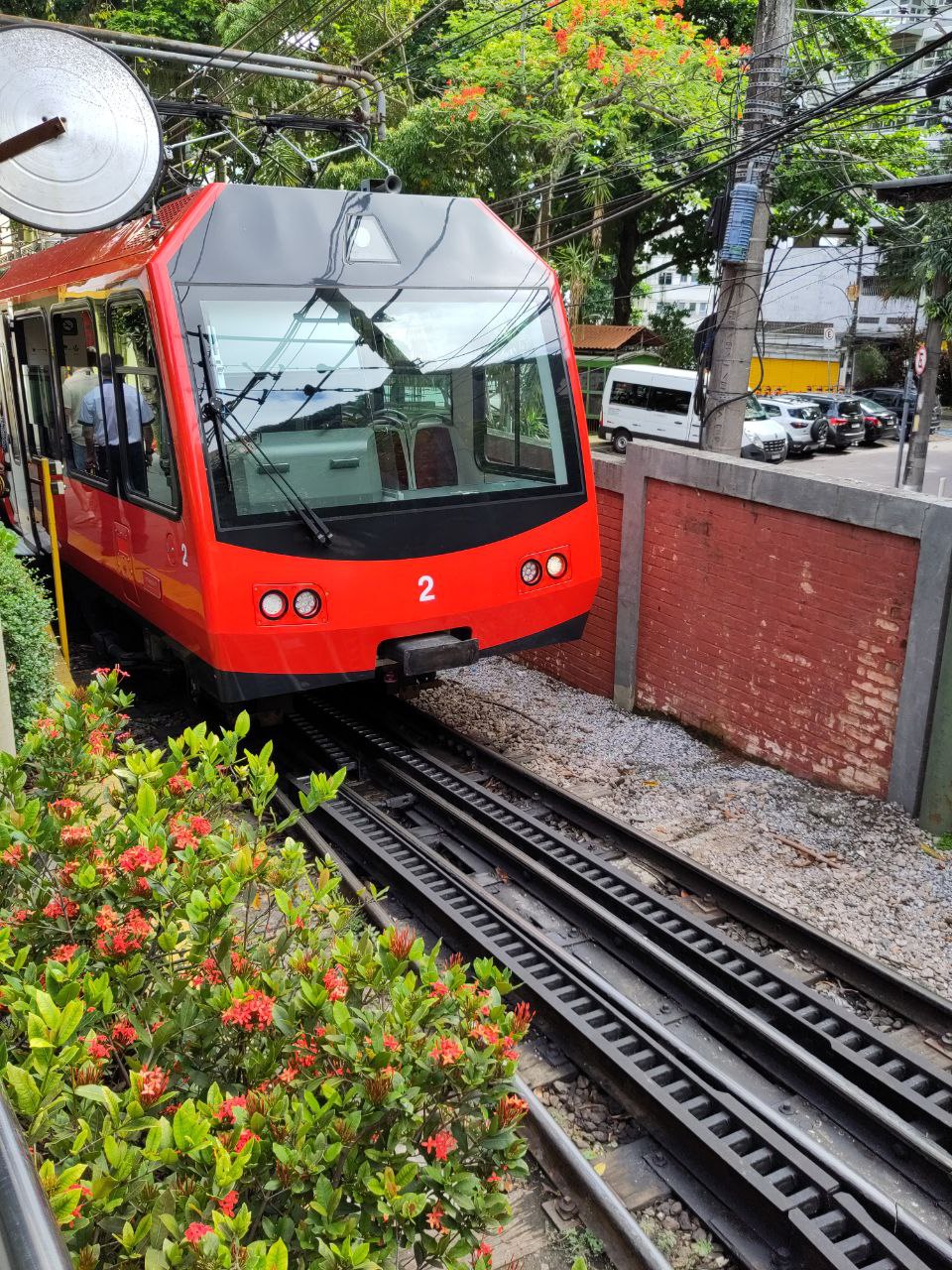
The cogwheel train which can be used to get up the Corcovado
The trip with the cogwheel train is really worth it, as it is a nice experience. They are operating multiple trolleys at the same time, so they also have switches for the cogwheel trains, which was very interesting. As the rails are going through the Tijuca national park, one has a very nice trip through the green.
Pão de Açúcar
Same as for the Redeemer is also true for the Pão de Açúcar (Sugarloaf mountain): go early, and buy from the official website: https://bondinho.com.br/ We were not asked for an ID here, but I had to give proof of my student status, which was not a big hustle.
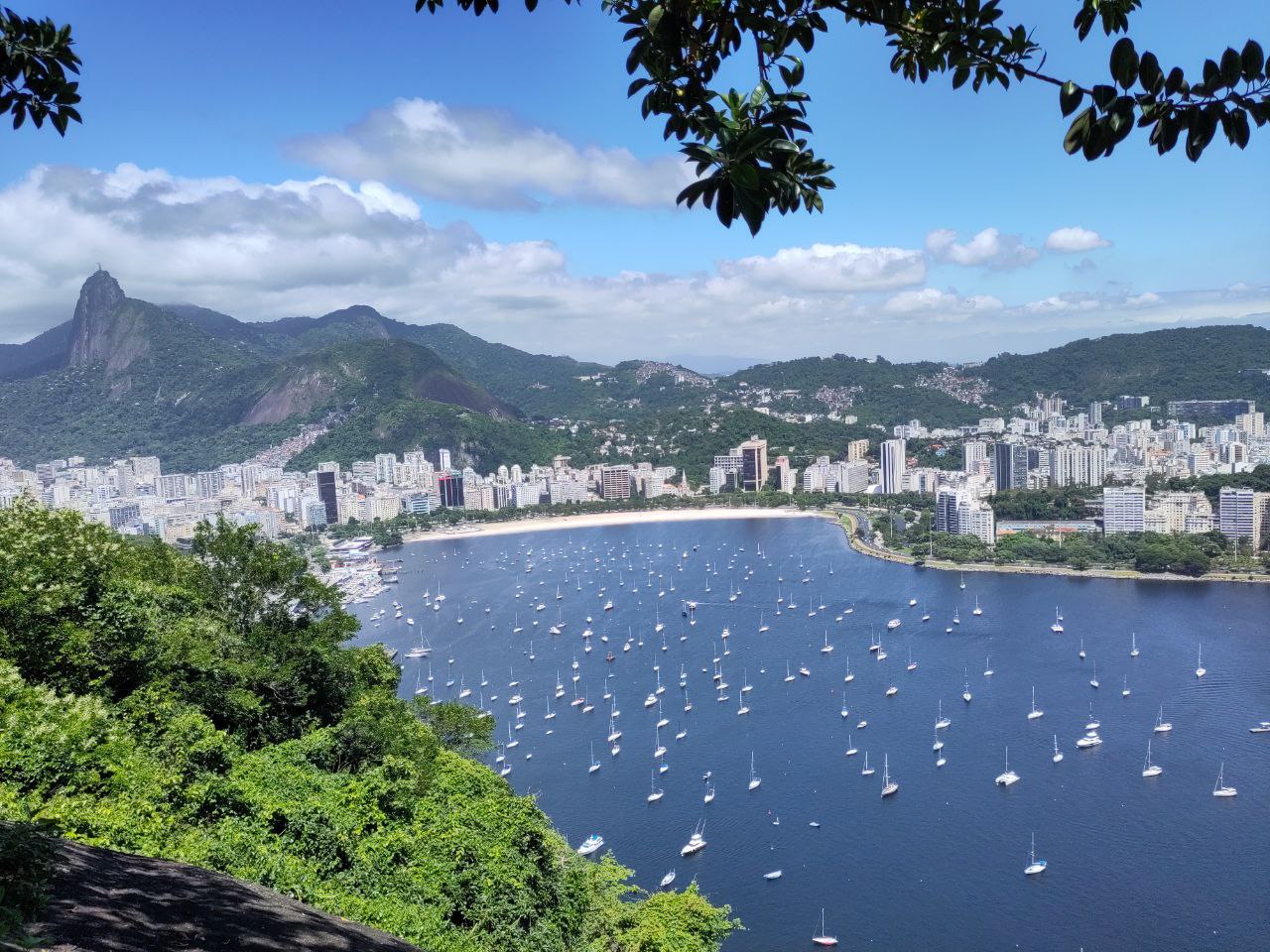
View on the city of Rio de Janeiro as seen from the Pão de Açúcar middle station
There are actually two cable cart rides to go up there, both have a very nice view, but are not as high as the Redeemer statue. The ride is really quick, there are only two carts which are always moving into the oposite direction.
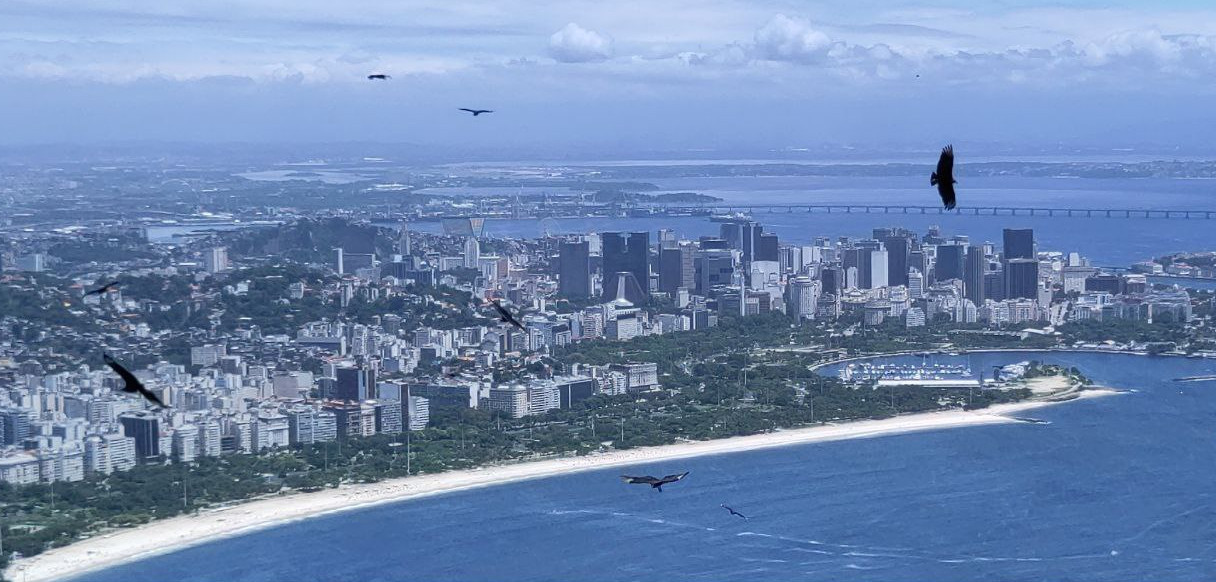
View on the city of Rio de Janeiro as seen from the Pão de Açúcar. One can see the Cathedral and the building behind, which also forms a cross on top of the cathedral
On top of the Sugarloaf, there is a place where one can go down on the other side which is not very well known and has only a few visitors. It has a nice view towards the sea and also places to sit and relax in the green, a little abroad from the touristic spots of the mountain.
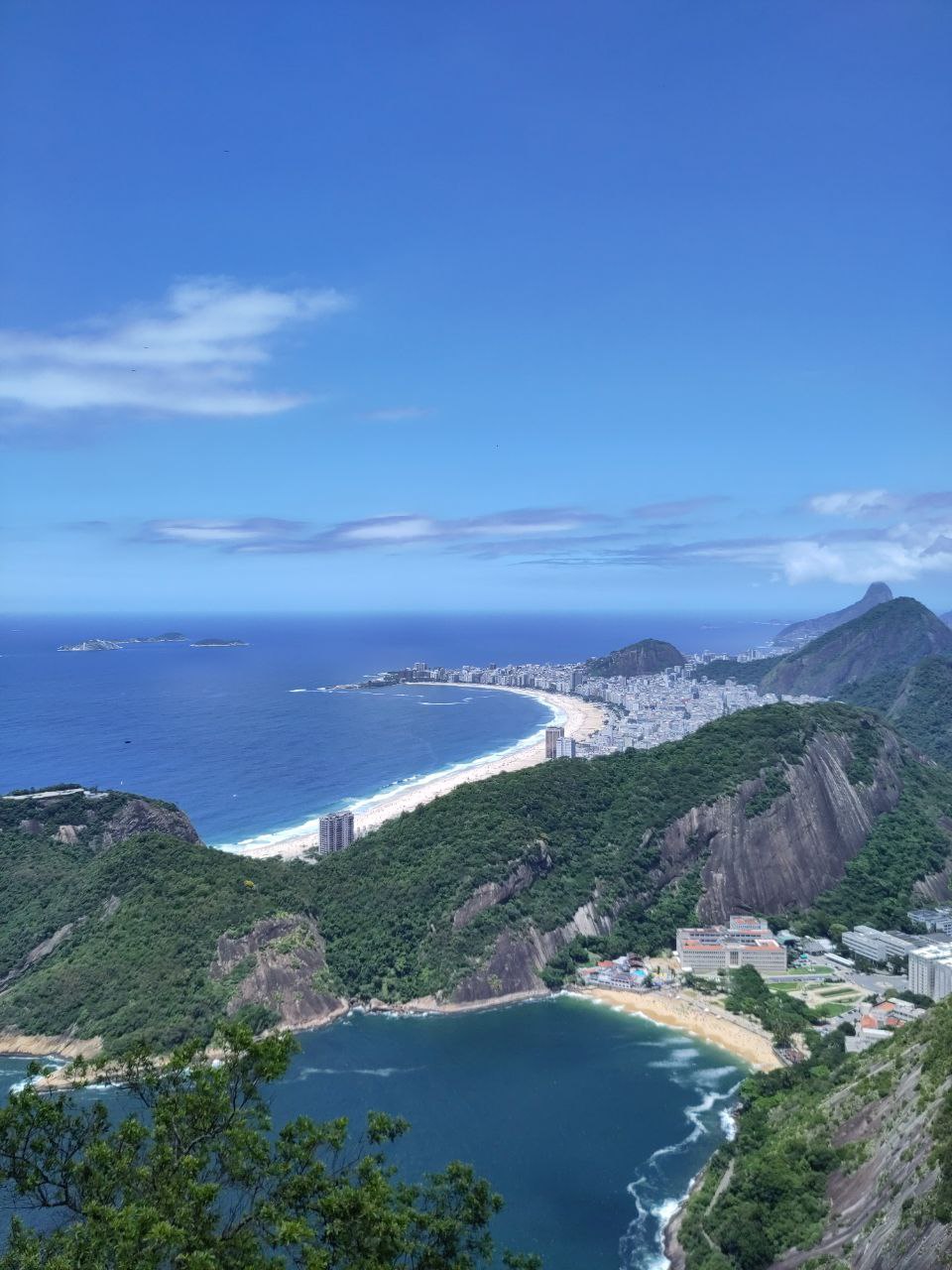
The copacabana beach as seen from the Pão de Açúcar
As we were already near the area, we afterwards took a walk towards the Copacabana.
Beaches - Copacabana & Ipanema
When we visited the beach in Rio de Janeiro, we did not feel very comfortable, as there were people trying to sell something every 20 meters. Even though this area is said to be safe, you can’t leave things unattended and always have to take care and keep an eye on your things. While taking an Uber, the driver told me to either close the window or take the phone away from the window, as some robbers grab you mobile phone out of the open window of cars. When staying at a bar with a fence, one should also watch out to not leave the things next to the fence, where passing people could grab things. I always had my belongings in a waist bag, and my phone in my trousers and did not have problems. I held the phone with both hands and took it only out for short times and after checking if it is safe enough.
You can not leave anything at the beach and go to the water, so you need to have someone to take care of your bags. There are people with a pavilion who are selling this service to you (besides of renting sunbeds and parasols), but we did not try that.
Fortunately, we had friends from the conference at the Ipanema beach, so we did take turns watching the stuff, while others are swimming in the sea.
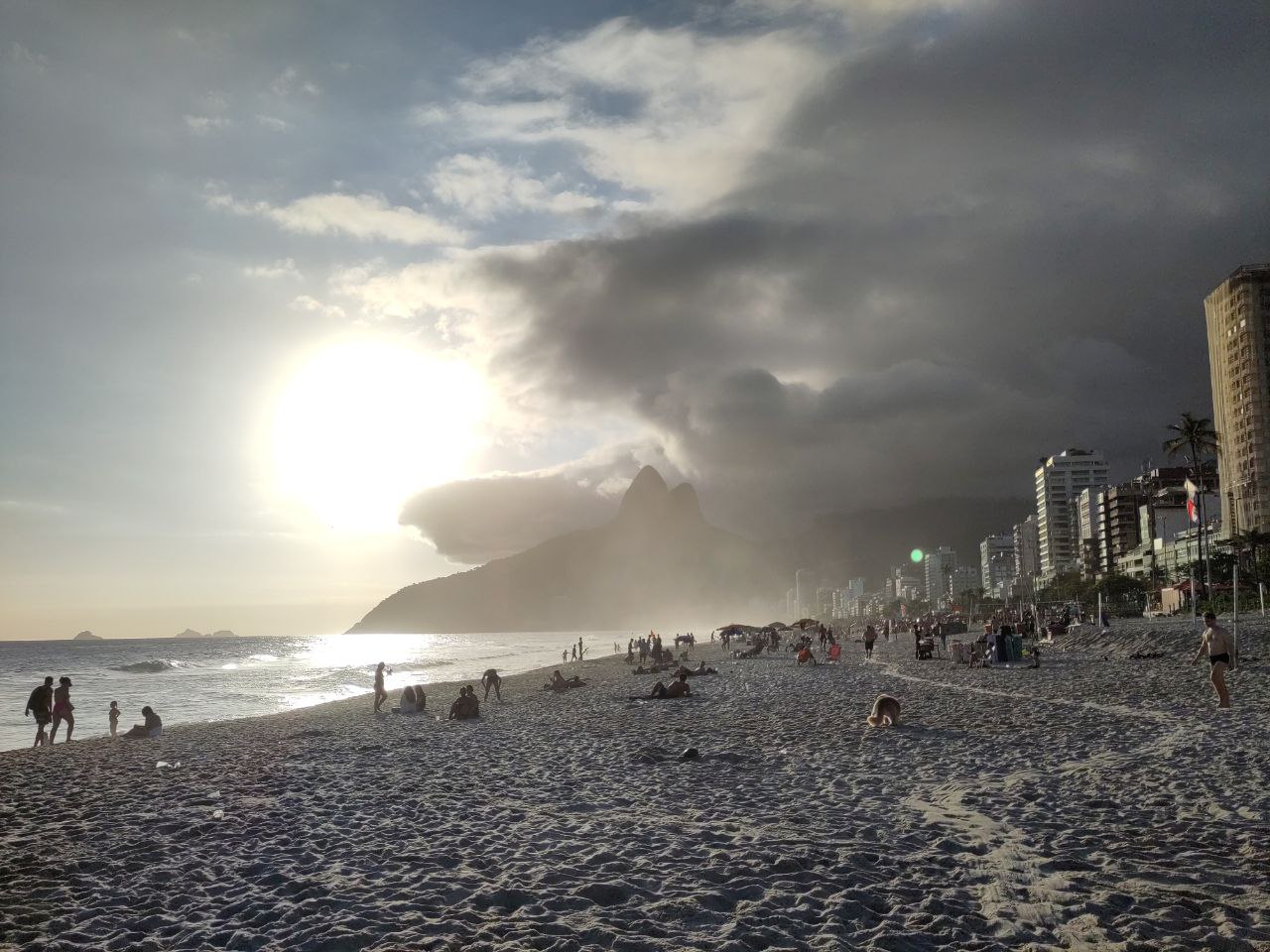
View on a Morro Dois Irmãos on a cloudy sunny afternoon at Ipanema
The beach in general is very nice, has very good sand, cool waves and good weather! Definitely worth it! Swimming was refreshing but not cold.
We also had a good time with Caipirinhas at a bar there, but it is much more expensive (and touristic) than in the City center in Lapa.
Museum of Tomorrow
To also see some culture of Rio, I visited the Museu do Amanhã - the museum of tomorrow. It is a science museum, but can be seen much more as a part of art in storytelling and providing known facts in a very intersting way. It has a story line of explaining the origin of the world, the importance of humanity, the problems which are raised from humans on this world and how the environment is destroyed and has an outlook into the future. It did cost 15 BRL for students, so its worth seeing. The building is also very nice and the surroundings are also nice to walk along.

View on the Museu do Amanhã in Rio de Janeiro near the water
At the last day, I just went to visit the city center another time. And did eat in Lapa again, which was quite a good thing, as it also was the first thing I did in Rio, but after staying here for a few days, I feel much more safe and can relax better.
We also went to a party there, the brazilian music is very different from what I am used too, so we visited a few different locations but did not settle somewhere.
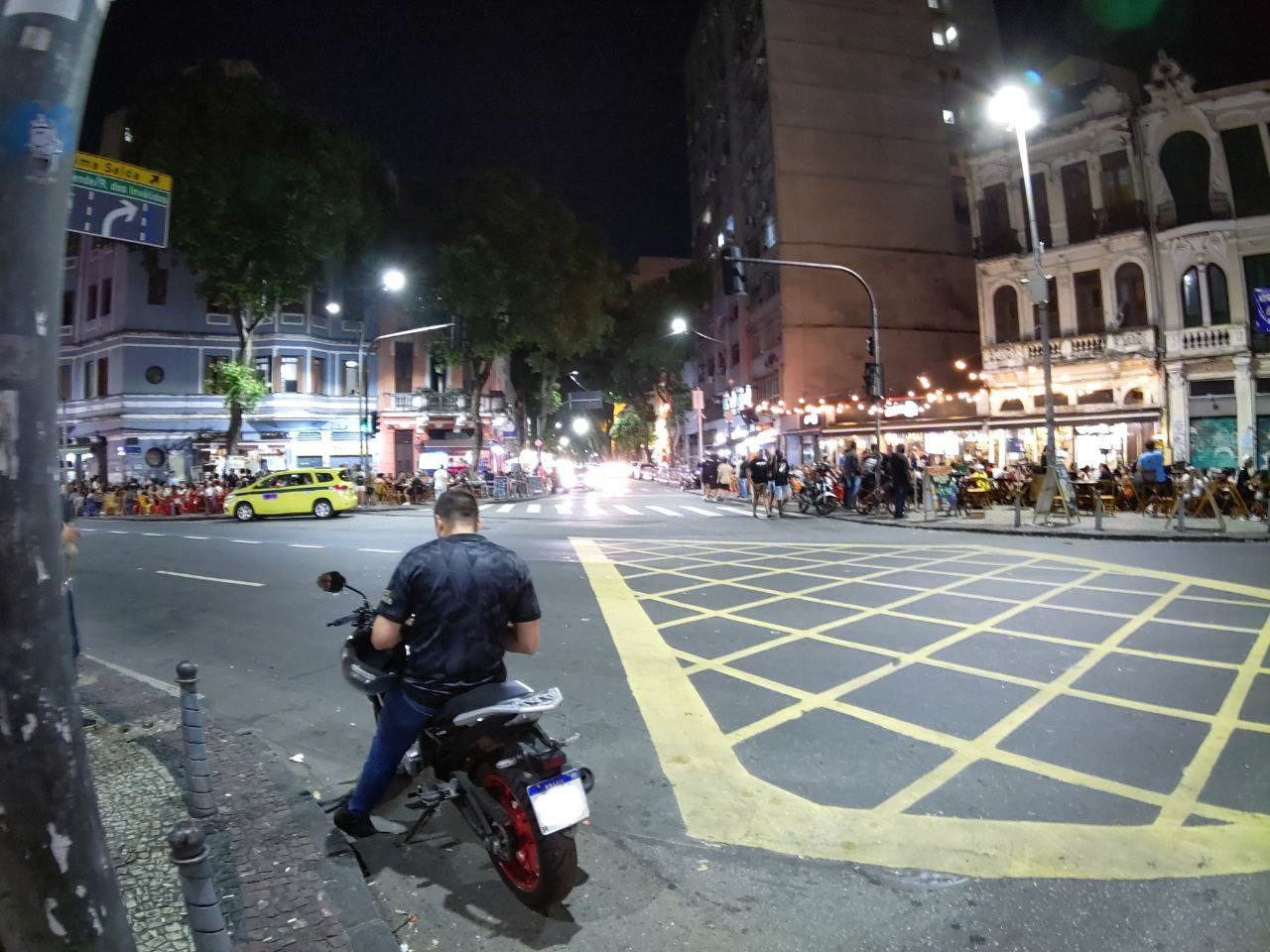
In lapa it is very crowded, but there are really many places to sit and eat something
Tomorrow is the flight back to Europe, I am really looking forward to it. Somehow, vacations always have the right duration for myself - so that I feel like it was a good time, it was enough time and I am also looking forward to being home too.